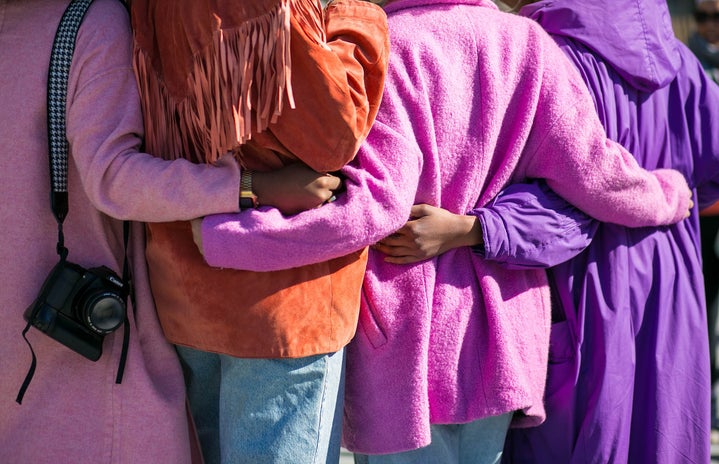I have always thought that more art needs to be made about platonic soulmates and the beauty of female friendships. My friendships are some of the most gorgeous and fulfilling things in my life, and I think these books capture the beauty of platonic love.
The Neapolitan Novels by Elena Ferrante
Elena Ferrante is one of my favourite writers – her books capture the complexities of the female psyche so effortlessly, especially in her novel Days of Abandonment. She writes under a pseudonym, and I wonder if that is because her own experiences of womanhood are deeply intertwined within her texts; she said she chose anonymity because her books stick ‘a finger in certain wounds I have that are still infected’. And I think you can definitely feel this rawness in the Neapolitan novels. My Mum’s friend gave them to me a few years ago, and they follow the lives of Elena and Lila, over 50 years or so, across four novels: My Brilliant friend, The Story of a New Name, Those Who Leave and Those Who Stay, and The Story of the Lost Child. From childhood to old age, the girls grow up amidst the poverty and violence of Naples, and Ferrante writes about the pressures of girlhood as the girls struggle with male desire and sexualisation. This imbues insecurities and physical comparison between them – the novels are from Elena’s point of view, and her narrative is thick with resentment and shame. The patriarchy so often instils this competitiveness into women, but this is so rarely explored in literature. I love that Ferrante doesn’t shy away from it – her characters feel deeply authentic and complex, as the friendship between Elena and Lila remains intimate and beautiful despite all these pressures.
Sula by Toni Morrison
Toni Morrison is such a beautiful writer, and in Sula, she explores the friendship of two girls, Sula and Nel, as they grow up in a black community in Medallion, Ohio. She writes about the pressures of living in a patriarchal and racist society, and Nel and Sula create a little world within each other, as a refuge from this:
“Because each had discovered years before that they were neither white nor male, and that all freedom and triumph was forbidden to them, they had to set about creating something else to be. Their meeting was fortunate, for it let them use each other to grow on. […] they found in each other’s eyes the intimacy they were looking for”
This passage is so gorgeous, and I’m just going to let Morrison’s writing speak for itself and tempt you into reading this book. Here is another beautiful passage, that Adrienne Rich talked about in her theory of compulsory heterosexuality, because it represents an enriching female friendship that exists so completely outside of patriarchal influence:
‘Nel was the one person who had wanted nothing from her. Who had accepted all aspects of her. Nel was one of the reasons Sula had drifted back to Medallion. The men had merged into one large personality: the same language of love, the same entertainments of love, the same cooling of love. Whenever she introduced her private thoughts into their rubbings and goings, they hooded their eyes. They taught her nothing but love tricks, shared nothing but worry, gave enough but money. She had been looking all along for a friend, and it took her a while to discover that a lover was not a comrade and could never be – for a woman’.
The Inseparables by Simone de Beauvoir
This novella is based on Simone de Beauvoir’s own relationship with her childhood best friend, Zaza Lacoin. She writes so beautifully about their passionate friendship – it follows the characters of Sylvie, based on Beauvoir, and Andrée, based on Lacoin. Although she wrote it in 1954, it wasn’t published until 2020 as she thought it was ‘too intimate’ to be published within her lifetime. She explores the pressures of girlhood in a similar way to Ferrante; the girls have enriching conversations about how women are treated in post WWI France, and their lack of social and political freedom as women were forced into arranged marriages and lives of domesticity. These conversations sent the girls into their own sphere of freedom – Sylvie, in particular, was intensely inspired by and in admiration of her best friend:
“What would I have daydreamed about? I loved Andrée above all else, and she was right next to me.”
Taste of Honey by Shelagh Delaney
My friend Evie gave me this play before I came to Bristol, and I immediately loved it for how funny Shelagh Delaney’s dialogue is. She writes about a working-class single mother and her daughter, Jo, who became pregnant with a black man’s baby. It was first performed in 1958, and was extremely radical at a time when British theatre centred almost entirely around white middle-class living. Jo is abandoned by those who should love her and is helped through her pregnancy by her best friend, Geoff, who she begins to call her ‘big sister’. They live together in Jo’s tiny Manchester apartment, and Geoff takes on the role of caring for Jo, but their relationship is never sexual – Geoff just has a deep desire to be with Jo and to love her platonically.
Frances Ha directed by Noah Baumbach, co-written with Greta Gerwig
This isn’t a book, but I couldn’t write on platonic love without mentioning this film. It follows Frances, a 27-year-old woman living in New York, who is constantly struggling to define her identity. She doesn’t really know what she’s doing with her life; she’s broke, her career as a dancer is (almost) failing, and she often finds herself looking for a place to live. But what seems to sustain her is her connection with her best friend Sophie. Just like the Neapolitan novels, this film shows the complexities of friendship – in Frances’ slight nervousness before she tells Sophie she loves her, or when she tries to argue that she is more book-smart than Sophie, or when she lies to Sophie about the realities of her dancing career. But the opening scenes of Frances and Sophie playfighting and resting their head on each other’s shoulders represents the giddiness of platonic love, and it’s something that Frances always returns home to:
It’s that thing when you’re with someone, and you love them and they know it, and they love you and you know it… but it’s a party… and you’re both talking to other people, and you’re laughing and shining… and you look across the room and catch each other’s eyes… but – but not because you’re possessive, or it’s precisely sexual… but because… that is your person in this life. And it’s funny and sad, but only because this life will end, and it’s this secret world that exists right there in public, unnoticed, that no one else knows about. It’s sort of like how they say that other dimensions exist all around us, but we don’t have the ability to perceive them. That’s – That’s what I want out of a relationship. Or just life, I guess.
And ultimately, she and Sophie share this moment at the end of the film:
‘Who are you making eyes at?’
‘That’s Sophie. she’s my best friend.’


